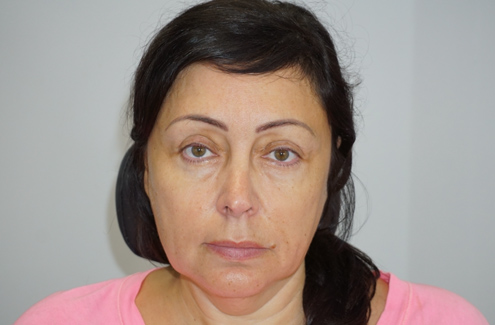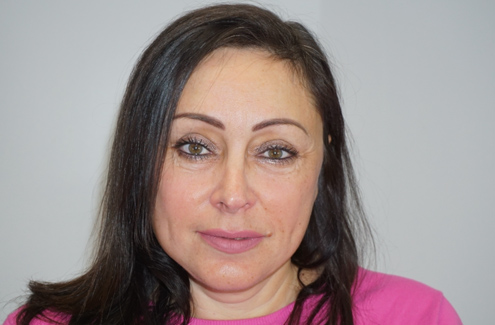
The Facelift is one of the most popular and talked about procedures in all of plastic surgery. This is because when it is done correctly, it can dramatically revitalize a person’s face. However, when done improperly, it can create a very poor, fake result that is obvious to the public and frequently talked about by others. Board-certified facial plastic surgeon Dr. Ruslan Zhuravsky prides himself on performing very high-quality facelifts that leave his Miami, FL patients happy with natural and stunning results.
Great facelift results are achieved by performing surgery that is detailed, precise, and addresses the true issues at hand. This means avoiding marketing gimmicks of some “breakthrough” new approaches that promise the same or more results with less surgery and less downtime. If it was that simple, everybody would do it. The truth is that a quality facelift is technically challenging and requires a high level of surgical expertise, rather than a secret method.
One of the biggest myths in facelift surgery is that less surgery leads to more natural results. In reality, less surgery usually means skipping or avoiding certain steps, which are usually the harder and more important ones. For example, skin-only excisions and quick SMAS pulls can result in the need for overcompensation, which creates an initially over-pulled appearance that fades along with the results. This often leaves patients disappointed with little to no results, wide scars, pulled (pixie) ear lobes, and other aesthetic issues that may be hard to correct.
These poor facelift results are seen too frequently in the public and are the reason that so many patients fear facelift surgery. The good news is that getting a facelift does not mean you have to look stretched, pulled, and distorted. A good facelift with the proper techniques will provide significant but natural results that will leave others wondering if you had surgery or are just genetically gifted.
This page was designed to give the patients of Dr. Z Face Plastic Surgery a comprehensive and straightforward understanding of facelift surgery. This information is beneficial for all patients to know, even if you are not our patient, it can help you choose a quality facelift surgeon that is right for you.

BEFORE & AFTERS
Peruse Dr. Ruslan Zhuravsky’s patient photo gallery to view his work and artistry on facial procedures like Rhinoplasty, Facelift, and more.
 before
before after
after

A Facelift is a cosmetic surgery that rejuvenates the face by elevating structures that have sagged over time. This primarily addresses the cheeks, jowls, jawline, excess skin, and most cases the neck. Although it can be incorporated into the surgery, anything above eye level is a brow lift.
The DETAILED answer:
The fancy surgical word for a facelift is rhytidectomy. The goal of the surgery is to reverse the signs of aging related to sagging and laxity of the face. This idea was introduced well over a century ago with simple excision of extra skin. We have come a long way since then, with the modern facelift focusing on the underlying structures of the face as the main target rather than simply removing the skin.
It is true that with time our facial skin loses its elastic nature and begins to sag down with gravity. However, this is only part of the big picture. The shapes of our faces are mostly determined by our bone structure, facial muscles, and fat pockets. If you imagine the face of someone who has lost an overwhelming amount of weight, what you start to see is the base bone structure with skin covering it and very little muscle or fat. This should help give an idea of the importance of these structures to our facial appearance. The skin is attached to a deeper layer called the SMAS, which stands for the superficial musculoaponeurotic system. This SMAS layer is what envelopes and holds much of our facial fat and muscles, thus it is the main target of the modern-day facelift.
The SMAS layer can be elevated in a few different ways, which are subject to debate among surgeons and discussed further below. Once the SMAS is elevated, it will give support to these deeper structures, improve the contours of the face, and allow for extra skin to be removed. An important point in all these methods is that the pulling happens in the deeper layer, and the skin is never subjected to excessive tension as this will often lead to complications.
So in summary, a quality facelift is the elevation of the deeper structures of the face including fat and muscle, along with the removal of the excess fat and skin.
A good candidate for a Miami Facelift is those in reasonably good health, have good skin elasticity, desire rejuvenation, and a willingness to have surgery with a 1 – 2 week recovery period.
The DETAILED answer:
The first and foremost factor is your level of health. We do facelifts for a wide range of ages, some in their 80s, as long as certain health risks are not exceeded. Conditions that require blood thinning medications can be an issue as they increase bleeding risk, but if stopped can lead to other serious health consequences. Smoking significantly increases the risk of complications from surgery, with some surgeons performing nicotine tests and refusing to operate on smokers, while others have them sign a waiver. A thorough and accurate health history is very important to discuss with your surgeon to make sure you are a candidate.
The desire to have a facelift is of course the next important aspect. This goes back to the section above on the benefits of a facelift. So the question is, if you are healthy enough and want a facelift, what would stop you? Four major things that hold people back from having a facelift are fear of recovery, fear of bad results, financial limitations, and inability to take time off. We describe the recovery details below, however, we can say that patients usually imagine it to be worse than it is. Botched and fake results of the face are hard to hide and so we see them out in the public, scaring people away from surgery. These over-pulled, stretched, and inflated faces are not the results of quality facelifts. Of course, the results can vary from patient to patient, but this is why it is very important to choose a surgeon who is going to do right by you and limit the chances for complications while providing the best results possible.
Financial constraints are very individual and a quality facelift can be very expensive. Everyone decides for themselves how they allocate their money. Not much advice can be given on this other than weighing out the benefits vs. what you feel their value is monetary.
Lastly, taking time off for recovery can be tough for many people unless they are retired or self-employed. The time off needed can vary from 1 – 2 weeks depending on your job.

Marketing campaigns have given rise to dozens of different types of Facelifts, but in reality, they are all modifications of a few core procedures. This has unfortunately created a great deal of confusion among patients. In general, facelifts are labeled based on how much of the face is being addressed and the method that is being used for elevation.
The DETAILED answer:
When patients come across a traditional Facelift that has a special name like “magic lift”, or “Best Lift”, or has a letter in front of the word lift, it is usually that surgeon’s brand name for their way of performing one of the few foundational lifts, sometimes with some modifications. It is important to understand which areas the lift is addressing and how it accomplishes that lift.
It is difficult to explain the details of the different types of facelifts, especially without a background in facial anatomy, but the following should give a general idea of the distinctions. It is strongly encouraged that you discuss the actual type of facelift with your surgeon and understand what they are offering.
One of the most confusing terms has been the “Mini-Facelift”. This can refer to either only a small skin pull, a small SMAS pull, and/or only a limited part of the face being addressed (ie cheeks and midface only). Another term is minimal access or short scar lift, which refers to making the incision smaller than the usual lift. This less invasive surgical procedure can be done if the amount of skin to remove is limited to a specific area.
The two major core techniques for this invasive surgical procedure are the SMAS facelift and the Deep Plane facelift. The SMAS lift is performed by first lifting the skin and then pulling the SMAS layer with sutures (stitches). The location and arrangement of these sutures differentiate the different types of SMAS lifts. When the SMAS is pulled it can be folded over onto itself, which is called plication, or it can be cut away and sutured together in a process called imbrication.
The Deep Plane Facelift procedure is another technique for facial rejuvenation surgery that starts with the same incisions and elevation of skin as the SMAS lift, however, the surgeon then dives into a layer underneath the SMAS. In this case, the SMAS is separated from its deep attachments and can be elevated by repositioning to a more youthful position rather than pulling on an SMAS that is still attached. This is a more technically challenging surgery. Dr. Zhuravsky typically performs deep plane facelifts as he feels this leads to overall better, more natural, and durable results. However, it is important to note that a well-performed SMAS lift can also yield good results, especially if the patient selection is right.
When you come in for your consultation, Dr. Z will be able to discuss your deep plane facelift cost, further elaborate on the advanced techniques it requires, and whether or not this invasive procedure is the right approach for your facial rejuvenation procedure.

The word Facelift is often used in our culture to refer to a fresh new face for something or someone. That is because it does just that for the human face, it refreshes and rejuvenates one’s appearance.
The DETAILED answer:
Our Facelift patients are the best source for the answer to this question. Before surgery, we often hear them describe that they look older than they feel inside. This is something that we have heard many times and contrasts to their feelings after surgery that their appearance reflects their inner self.
Other patients describe a sense of pride and confidence when they are out socially, amongst friends, or even on a video call for work. Some patients have even explained that they have a more fruitful and active social life just from the confidence they have gained.
We also hear patients explain that they are not self-conscious of their age, and, want to look their age, but a refreshed version of themselves.
If you are interested in a facelift and reading this, you probably have some idea of the benefits you desire from a facelift. Review images of patients with (good) facelifts, imagine that level of result on yourself, and you might have more insight into your desire for a facelift. It is important to discuss these goals and feelings with your surgeon as part of your consultation.
Incisions are made near the hairline and ears to conceal them. The skin is then separated (lifted) from the layer below. In a deep plane or standard SMAS lift, sutures (stitches) are used to pull the SMAS in a favorable trajectory (up and back), attaching them to more stable areas just in front of the ear. In a deep plane lift, loose skin around the SMAS is also elevated and then repositioned to the desired location. The extra skin is cut away and the incisions are closed.
The DETAILED answer:
Facelift surgery in Miami can be performed under general anesthesia, sedation, or local anesthesia. The choice depends on the patient’s desire, the surgeon’s preference, and the patient’s ability to tolerate anesthesia. The differences are discussed in the section below. In any case, once the patient is ready for surgery, a mixture of medications called tumescent is injected under the skin throughout the areas being operated on. In awake local anesthesia patients this makes the face fully numb, allowing us to operate without the patient feeling any pain. In all cases, it helps to close down small vessels and prevent bleeding during surgery.
In most facelifts, the neck is addressed first as an incision is made just underneath the chin approximately 3 cm across. The skin of the neck is then lifted through this incision. From here the surgeon can now address the platysma muscles, which are the SMAS of the neck. The simplest way to approach this is to suture the left and right platysma muscles together along the midline. Dr. Zhuravsky prefers the more comprehensive deep approach for most cases, as this leads to a much nicer, crisp neckline with good longevity. In this approach, the platysma muscles are also elevated and any fat below them is removed. The muscles are partially cut across at the angle of the neck to accentuate this area and prevent them from recreating the vertical bands. The muscles are then tied together with sutures as well as to the deeper structures to give maximal results. In some cases it is even possible to remove part of a deeper muscle and saliva gland, however, this is judged on a case-to-case basis. The incision is then closed with stitches.
The facelift incision is easier to see rather than describe. It starts just in front of the hairline in the temple area then swings around the sideburn and over to the ear. In front of the ear, the incision is strategically placed in areas where it will be least visible, hiding in a crease as well as behind the tragus (a little part in front of the ear canal). This then continues around the back of the ear and then down the hairline behind the ear.
The skin is then lifted. In most traditional SMAS facelifts the SMAS is pulled up and back along the most favorable trajectory. The sutures act as support ropes that anchor the SMAS to more stable points further back on the face. In a deep plane facelift, the SMAS and the platysma (outer portion this time) are elevated as their attachments to the bone and deeper structures are carefully separated. The SMAS is then repositioned and sutured in place. A partial cut is made in the platysma just under the jawline. The platysma is then pulled under the jawline and attached behind the ear, giving a more defined and crisp jawline, as well as a tighter neck. Once all these deep areas are repositioned, the skin is gently laid back down. Because the deeper structure has been suspended, the overlying skin is now also lifted. The extra skin is cut away and the incisions are closed. Some surgeons use drains, however, this is not common practice for Dr. Zhuravsky. We place our patients in a compression wrap and the procedure is complete.
The bulk of the recovery is during the first week with the majority of pain/discomfort in the first 1 -2 days. The rest of the week is marked by swelling, tightness, and compression. The bulk of the “recovery period” is 1 – 2 weeks.
The DETAILED answer:
Recovery after a facelift can vary but in most cases ranges from 1 – 2 weeks. Most of the discomfort is experienced during the first 2 days with the rest of the week being described as a mild dull ache or tightness that can be managed with Tylenol. Patients wear a bulky tight compression around the face for the first 24 hours to help minimize swelling. This is exchanged in the office for a lighter elastic compression garment that patients wear for the rest of the week, removing it twice daily to shower and clean. Dr. Zhuravsky does NOT routinely use drains, but in the very rare case that a drain is required, it is usually removed after 1-2 days.
Bruising is not often an issue as most of the central work is done in the deep plane. Most of the bruising occurs behind the ears and along the neck. This is either fully faded or partially reduced and can be covered with makeup for 1 week. In some cases, there is bruising on the sides of the chin, where we release the mandibular ligament. This also fades and can usually be covered up by 1 week. We provide a full list of instructions but the general idea is to avoid strenuous activity like heavy lifting or bending over, keep the incision lines clean, avoid sun exposure, and restrict anything that might impact healing like smoking and alcohol. Hair can be gently washed with non-irritating shampoo after 3 days.
At the 1 week visit, the compression can finally be taken off and left off, however, some patients prefer to wear this at night time for another week or more. This is also when the sutures (stitches) are removed. At this point, there is still moderate swelling that is generally around the peripheral (outer) parts of the face. This is because these are the areas where we elevate skin only and attach our SMAS. The corner of the jaw, in front of the ear lobe, and the temple area will typically have the most swelling and puffiness. This gives the face a round and full appearance but is usually socially acceptable. Even those on the higher end of swelling will usually be able to go out in public with their hair down or a scar around the face and neck.
Swelling and tightness are the two biggest things patients notice during the second week. Both are signs of aging but these issues improve daily and can usually be helped with warm (NOT hot) compresses if cleared by the surgeon.
While patients appreciate a significant improvement in their appearance as early as week 1, they are usually most satisfied around weeks 3 – 6 when the majority of the swelling has resolved and they can show off their new look to their friends.


Dr. Zhuravsky is a board-certified facial plastic surgeon devoted to cosmetic plastic surgery of the face. He has performed facelifts for various age groups of men and women throughout Miami and Northeast, Florida, as well as other distant locations. Patients choose Dr. Zhuravsky for his high level of expertise and dedication to achieving the most optimal results possible each and every time. As someone who has seen and corrected issues from other facelifts, Dr. Z strongly believes in doing things the right way or not at all. So if you’re considering a facelift with Dr.Z, you can expect top-level quality without any placebo or gimmick lifts. Overall, Dr. Zhuravsky performs Deep plane facelifts as his lift of choice due to the very natural and significant results it has allowed him to achieve for his patients. There are cases where he might find mini SMAS lifts appropriate, but these must be selected carefully.
Facelifts in Miami are one of the more costly procedures in plastic surgery due to all the complexity described above and the fact that they involve a person’s face, something that is hard to disguise. A good quality facelift takes a great deal of skill and effort to complete, thus a surgeon’s abilities and dedication will be a cost factor.
The extent of the individual facelift, the amount of work required, and other matters such as surgeon and anesthesia fees also affect the overall facelift cost Even with the same facelift approach, some require more work than others.
Also, as with all things, prices change and tend to increase with time. Due to these reasons we cannot post prices online, however, will be happy to give you a ballpark if you call, and a quote after the examination. In general, we try to keep our pricing at a fair level relative to the expertise and quality provided.

If it’s time to get rid of those telltale signs of facial aging, you should come into Dr. Z Face Plastic Surgery for a Facelift consultation in Miami, FL. You can call us directly at (786) 347-6211, or use our website to contact us for an appointment request and a member of our team will be in touch with you.